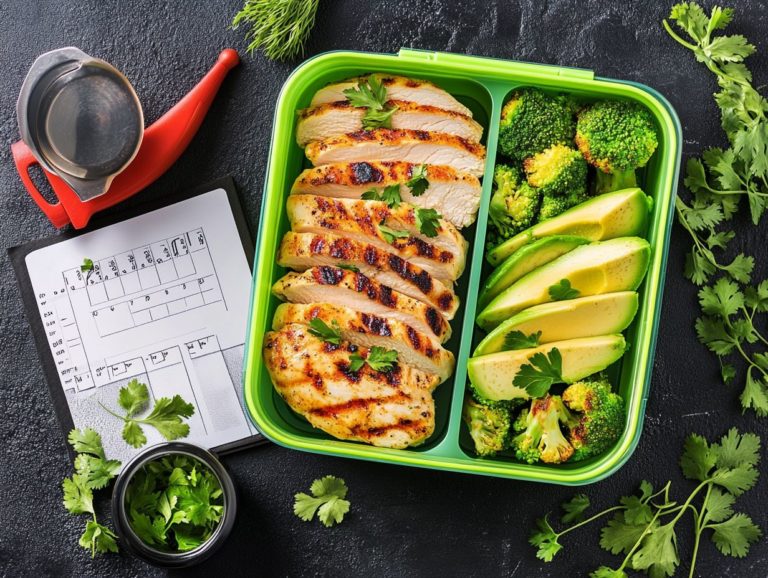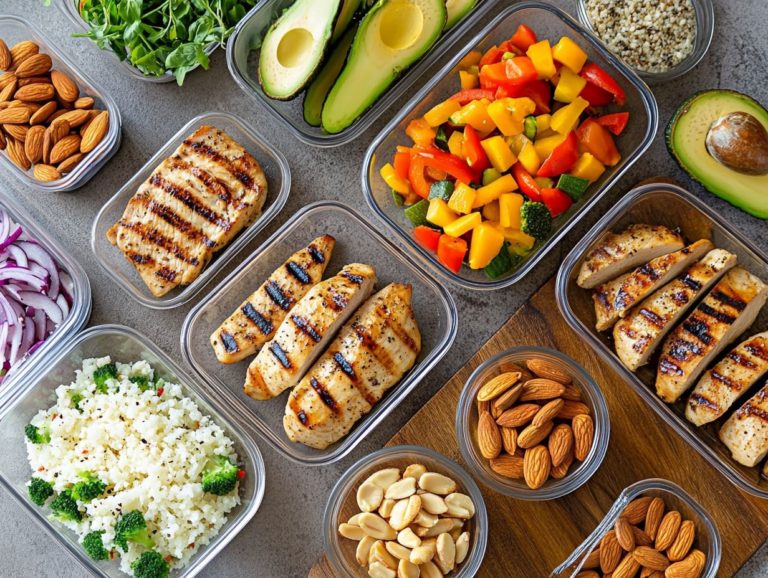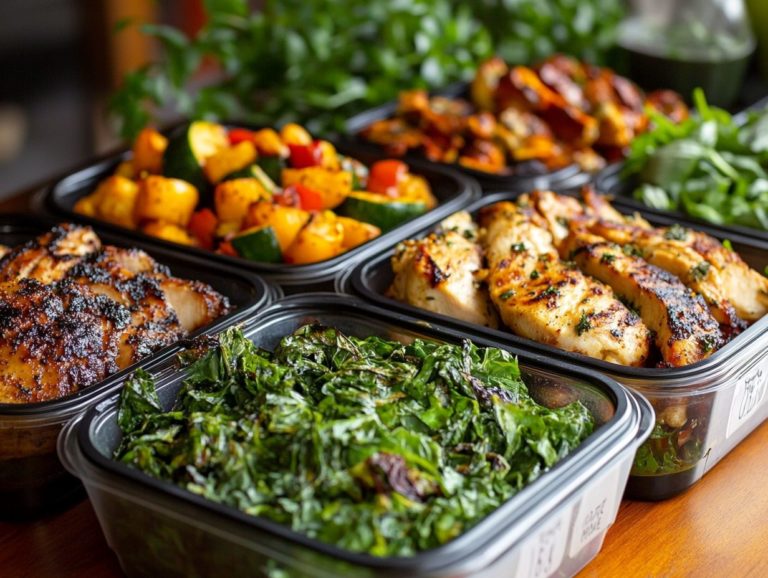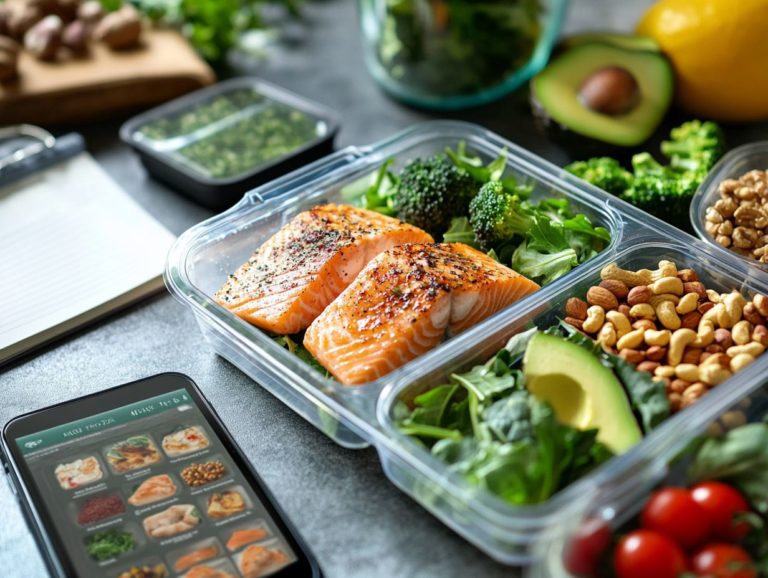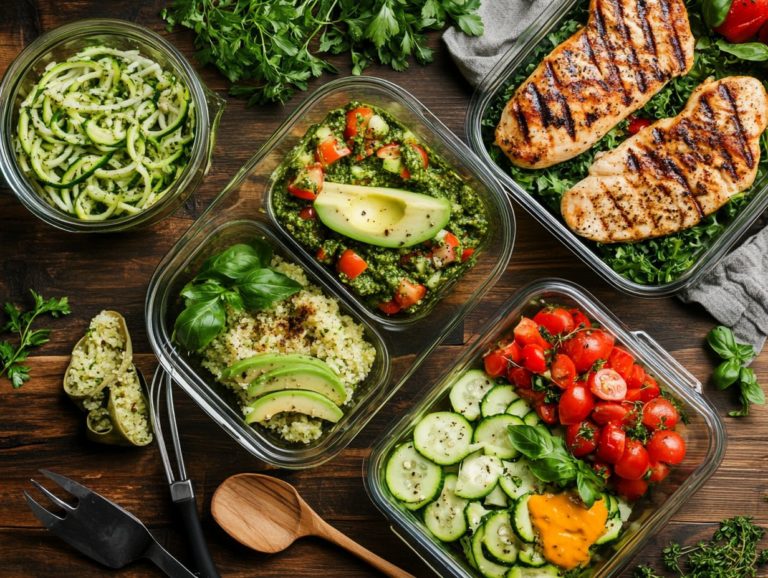Balancing Macronutrients in Keto Meal Prep
Keto meal prep presents you with a practical and efficient approach to fully embrace a low-carb lifestyle, all while relishing delightful and satisfying meals. It conserves your time and money, aids in portion control, and encourages healthier eating habits, especially beneficial for those managing insulin resistance.
This guide delves into the numerous benefits of keto meal prep, offering insightful planning tips and highlighting essential macronutrients to keep in mind. You ll find a collection of delicious keto recipes and helpful strategies to steer clear of common pitfalls, ensuring that your keto journey is both enjoyable and successful.
Contents
- Key Takeaways:
- What are the Benefits of Keto Meal Prep?
- 3. Promotes Healthier Eating Habits
- How to Plan a Keto Meal Prep?
- Essential Macronutrients for Keto Meal Prep
- How to Balance Macronutrients in Keto Meal Prep for Optimal Health?
- 1. Use a Food Scale for Accurate Measurements
- 2. Track Your Macros to Maintain a Balanced Diet
- 3. Adjust as Needed for Optimal Health
- What are Some Sample Keto Meal Prep Recipes for a Balanced Diet?
- 1. Chicken and Broccoli Alfredo: A Ketogenic Favorite
- 2. Salmon and Asparagus Salad
- 3. Cauliflower Fried Rice: A Low-Carb Delight
- How to Store and Reheat Keto Meal Prep Meals for Maximum Freshness?
- What are Some Common Mistakes to Avoid in Keto Meal Prep?
- Frequently Asked Questions
- What are macronutrients and why are they important to balance in keto meal prep?
- What is the ideal macronutrient ratio for a keto meal prep?
- How can I ensure I am balancing my macros in my keto meal prep?
- Can I still consume my favorite foods while balancing macronutrients in keto meal prep?
- What happens if I do not balance my macros in keto meal prep?
- Are there any tools or resources available to help with balancing macros in keto meal prep?
Key Takeaways:
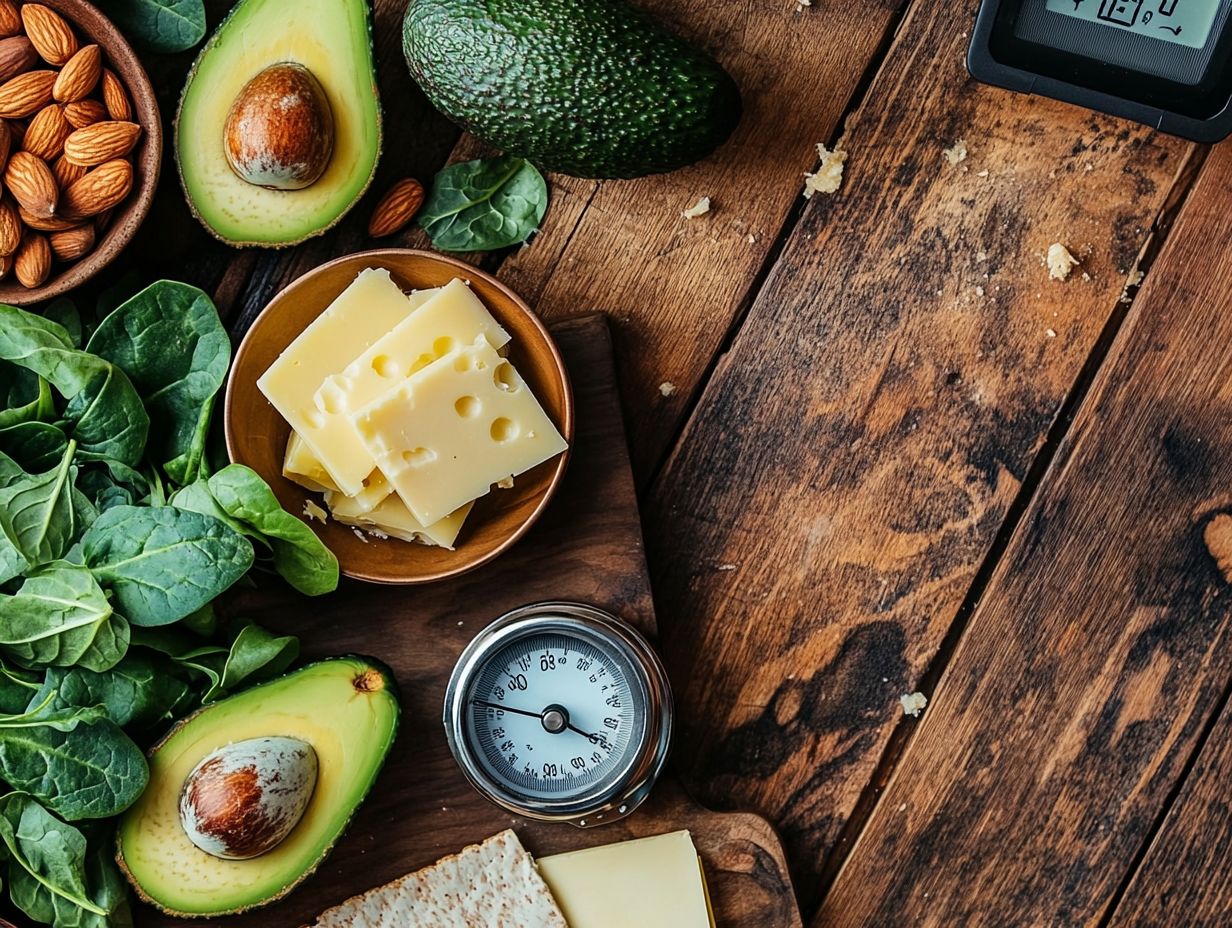
What are the Benefits of Keto Meal Prep?
Keto meal prep presents a wealth of benefits that can significantly enhance your experience on the ketogenic diet, especially if you’re focused on effective weight loss and improved health. By embracing a structured approach to preparing your meals in advance, you can save both time and money while ensuring that your diet remains compliant with low-carbohydrate, high-fat options.
This strategy minimizes the risk of meal prep burnout and encourages healthier eating habits and better portion control both crucial for your long-term success on the ketogenic path. Meal prep also helps manage food cravings, supports appetite suppression, and helps maintain satiety levels, all of which contribute to your overall wellness.
1. Saves Time and Money
One of the primary advantages of keto meal prep lies in its remarkable ability to save you both time and money, making it an enticing strategy for anyone embracing a ketogenic diet.
By planning and preparing your meals in advance, you can purchase ingredients in bulk, leading to significant savings at the grocery store. This method streamlines the cooking process, cutting down on daily decision-making, while allowing you to select seasonal produce and protein sources with care, ultimately minimizing waste.
Employing meal planning techniques focused on versatile ingredients allows you to create a variety of keto-friendly dishes effortlessly, ensuring nothing goes to waste. Organizing your grocery list based on a thoughtfully crafted keto menu helps you stick to your budget and avoid impulse purchases, making it easier to meet your financial goals while savoring a delicious, low-carb lifestyle. Embrace this strategy to transform your diet!
2. Helps with Portion Control
Keto meal prep plays an important part in helping you master portion control, which is crucial for maintaining dietary compliance and achieving your weight loss goals within the ketogenic diet.
By planning and preparing your meals in advance, you can more easily stick to your specific caloric limits and desired macronutrient ratios. This proactive approach simplifies the decision-making process on those hectic days and aids in appetite suppression by ensuring that nutrient-dense foods are readily available.
When your meals are balanced according to dietary guidelines and include appropriate fiber intake, you re less likely to give in to impulse eating or opt for unhealthy alternatives. The ability to measure portions and incorporate the right balance of fats, proteins, and carbohydrates solidifies your commitment to a successful and sustainable way of eating, which is particularly important for individuals managing health conditions such as diabetes and obesity.
Start your meal prep journey today for a healthier lifestyle!
3. Promotes Healthier Eating Habits
Incorporating keto meal prep into your routine promotes healthier eating habits that align beautifully with a low-carbohydrate, high-fat diet and other high-protein diets like the Atkins and Paleo diets.
This approach encourages you to choose nutrient-rich foods such as avocados, leafy greens, and lean proteins, while helping you resist the allure of processed convenience foods that can derail your dietary goals and disrupt ketosis.
By planning your meals in advance, you can closely monitor your macronutrient intake, ensuring you stay within the ideal range to enjoy the long-term health benefits of a ketogenic lifestyle. This helps prevent conditions like ketoacidosis and supports overall metabolic health.
As your commitment to healthy eating strengthens, you ll find it easier to make choices that support your wellness and enhance metabolic efficiency. This sets the stage for sustainable weight management and improved energy levels, allowing you to thrive on your journey while addressing metabolic risk factors.
How to Plan a Keto Meal Prep?
Planning successful keto meal prep requires a strategic mindset centered on understanding your nutritional needs. Select keto-friendly foods that satisfy your palate and align with your dietary goals and restrictions.
1. Determine Your Nutritional Needs
Determining your nutritional needs is essential for managing glucose production and fat metabolism, which are critical in a ketogenic diet.
The first step in planning your keto meal prep is accurately determining your nutritional needs. This will guide your food choices and portion sizes.
Understanding your individual health goals is crucial. Different objectives, such as weight loss or muscle gain, demand distinct approaches. To customize your ratios of protein, fat, and carbohydrates, consider your current activity levels. If you engage in intense workouts, increase your protein intake for optimal muscle recovery. A more sedentary lifestyle may allow for more focus on healthy fats.
Consider any existing health conditions like type 2 diabetes that may require specific dietary adjustments. Your personal dietary preferences, such as vegetarian or gluten-free options, also play a significant role in these calculations. By thoughtfully evaluating these factors, you can adjust your macro ratios to support metabolic changes, enhance energy levels, and optimize your weight loss journey. Stay informed with research findings that offer insights into effective dietary strategies.
2. Choose Keto-Friendly Foods
Selecting keto-friendly foods is essential for successful meal prep, as it directly impacts your ability to maintain ketosis and achieve your health goals.
As you embark on this low-carbohydrate journey, incorporate healthy fats like avocados, olive oil, and coconut oil as your primary energy sources. Include proteins such as grass-fed meats, wild-caught fish, and free-range eggs; they promote muscle retention and help you feel satiated.
Low-carb vegetables, including leafy greens, broccoli, and zucchini, are excellent choices for maintaining your micronutrient intake without exceeding carb limits. Avoid sugar-laden products, grains, and starchy vegetables, as these can disrupt the delicate balance needed for ketosis. Proper vegetable intake prevents nutrient deficiencies and maintains overall health.
Finally, monitor your total caloric intake, ensuring that your meals align with your dietary restrictions while remaining balanced and nutritious. Maintaining the right balance between carb restriction and caloric intake is key to achieving ketosis.
3. Calculate Serving Sizes
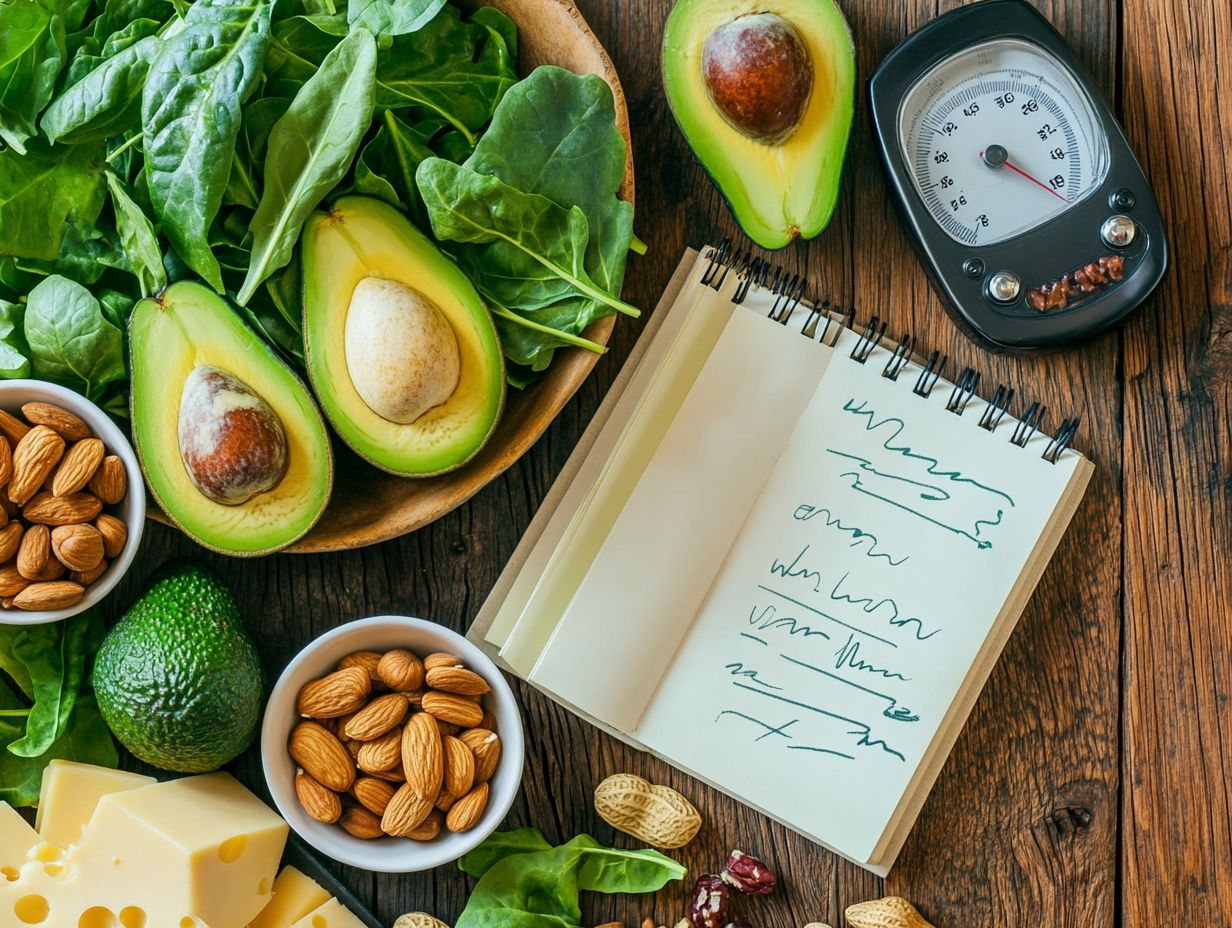
To achieve success with your keto meal prep, it s essential to calculate appropriate serving sizes. This practice helps you manage your caloric intake. It also ensures you meet your dietary goals and manage health conditions like insulin resistance.
Understanding portion control is key; it prevents overeating while playing a vital role in achieving the macronutrient ratios necessary for supporting ketosis. By accurately measuring your serving sizes, you can effectively balance your intake of fats, proteins, and carbohydrates. This balance is crucial for maintaining energy levels and promoting fat burning.
Knowing the right portions will make you feel satisfied and happy! This mindful approach to eating nurtures healthier habits, reinforcing your long-term commitment to a ketogenic lifestyle and ultimately enhancing your overall wellness. Don’t forget to regularly update your meal planning to stay on track and excited about your progress!
Essential Macronutrients for Keto Meal Prep
Grasping the essential macronutrients for keto meal prep is crucial for successfully embracing a ketogenic diet while steering clear of potential nutrient deficiencies. Macronutrients are nutrients you need in larger amounts, including proteins, fats, and carbohydrates. It’s important to remember that the long-term effects of a ketogenic diet can vary, so regular monitoring of your dietary strategy is essential.
1. Protein
Protein stands as a vital macronutrient in your ketogenic journey, playing a crucial role in muscle maintenance and overall body function. It not only preserves your lean muscle mass while you navigate a low-carb regimen, but also promotes a sense of fullness, essential for curbing cravings and managing your weight effectively.
Be mindful of your protein intake, as it is crucial for overall health and can help prevent issues like ghrelin imbalance. You have a plethora of high-quality protein sources at your disposal on keto. Consider indulging in fatty fish like salmon, which is rich in omega-3s, and grass-fed meats that offer superior nutrients. Eggs, a staple in many keto meals, present an excellent protein-to-fat ratio and are remarkably easy to prepare.
Incorporating these foods into your meal prep can be a delightful endeavor. Picture yourself creating hearty omelets, versatile stir-fries, or flavorful grilled dishes that strike the perfect balance and satisfy your hunger. This will ensure that you consistently meet your protein intake throughout your diet. Batch cooking these dishes can save you time and help you stay on track with your dietary goals.
2. Fat
Healthy fats are the cornerstone of your ketogenic diet, serving as your primary energy source and facilitating the process of ketosis. This dietary strategy is crucial for maintaining your ketogenic lifestyle.
These beneficial fats do more than just fuel your body; they also play a crucial role in maintaining cellular health and promoting the absorption of essential vitamins. Healthy fats also contribute to appetite suppression and managing insulin resistance, which are significant health benefits of a ketogenic diet.
In crafting a well-structured keto meal prep plan, it’s vital for you to incorporate a variety of healthy fats and protein sources. Think avocados, olive oil, and fatty fish these sources contribute to optimal fat metabolism, allowing your body to efficiently convert stored fat into usable energy. These ketogenic foods are part of a low-carbohydrate diet that aids in managing your blood glucose levels.
Nuts and seeds provide a perfect blend of omega-3 and omega-6 fatty acids, which are essential for reducing inflammation, supporting heart health, and addressing metabolic risk factors. By prioritizing these nutrient-dense fats, you can enhance your overall well-being while successfully adhering to your low-carb lifestyle.
3. Carbohydrates in a Low-Carbohydrate Diet
While carbohydrates are undeniably a vital macronutrient, those embracing a ketogenic diet must impose strict carb restrictions to maintain that coveted state of ketosis. This carb restriction is essential for managing insulin and glucose levels, which is particularly beneficial for those with type 2 diabetes and other health conditions.
This discipline helps achieve and maintain a state where your body burns fat for fuel. It also curtails glucose production and improves insulin sensitivity, both of which can obstruct your weight loss objectives and overall health benefits.
To effectively navigate the landscape of carbohydrates suitable for keto-friendly meal prep, focus on net carbs a calculation that deducts fiber and certain sugar alcohols from total carbohydrates. This approach helps manage your daily carb intake and avoid foods that may disrupt ketosis.
By doing so, you can pinpoint which carbs to incorporate or eliminate from your meals, ensuring that your dietary choices support your nutritional aspirations while preserving the delicate equilibrium essential for ketosis.
How to Balance Macronutrients in Keto Meal Prep for Optimal Health?
Balancing macronutrients in your keto meal prep is crucial for achieving your dietary goals, maintaining optimal energy levels, and preventing nutrient deficiencies.
Thoughtfully considering the proportions of fats, proteins, and carbohydrates sets you up for success on your keto journey. This balance is essential in avoiding a dangerous condition that can happen when your body produces too many ketones.
This careful approach not only supports your nutritional needs but also enhances your overall well-being.
1. Use a Food Scale for Accurate Measurements
Using a food scale is an effective way to measure portion sizes accurately and ensure that your macronutrient ratios are just right in your keto meal prep. This practice keeps you on track and excited about your meals!
This tool is essential for maintaining dietary compliance, especially if you like to keep a close eye on caloric intake and follow specific eating plans. It is particularly useful for people with dietary restrictions requiring precise measurements of food groups.
By providing precise measurements, a food scale takes the guesswork out of portion sizes, preventing the pitfalls of unintentional overconsumption or undernutrition.
If you’re serious about hitting your health goals whether you’re looking to shed pounds or build muscle utilizing a food scale ensures that each meal meets your dietary needs. This is especially important for those adhering to high-protein diets or dealing with obesity treatment.
As a result, consistently using this device promotes healthier eating habits, fostering a greater awareness of serving sizes and nutritional values, which ultimately supports long-term lifestyle changes.
2. Track Your Macros to Maintain a Balanced Diet
Tracking your macros is an essential aspect of successful keto meal prep, as it allows you to maintain the precise macronutrient ratios aligned with your dietary goals while monitoring potential nutrient deficiencies.
Diligently monitoring your intake of carbohydrates, proteins, and fats ensures that you stay within the recommended limits for a ketogenic diet. This paves the way for favorable metabolic changes that support weight loss, satiety levels, and stable energy levels.
You have a variety of methods at your disposal for this practice, from intuitive apps that allow for quick barcode scanning and meal logging to traditional food journals where you can manually record your meals and analyze patterns over time. These methods are particularly useful in managing dietary challenges and staying compliant with ketogenic dietary guidelines.
These tools not only streamline the process of tracking macronutrients but also encourage long-term adherence to dietary guidelines. Start tracking today for better health! This practice ultimately fosters healthier eating habits and sustained success in achieving your nutritional objectives while also preventing food cravings and metabolic risk factors.
3. Adjust as Needed for Optimal Health
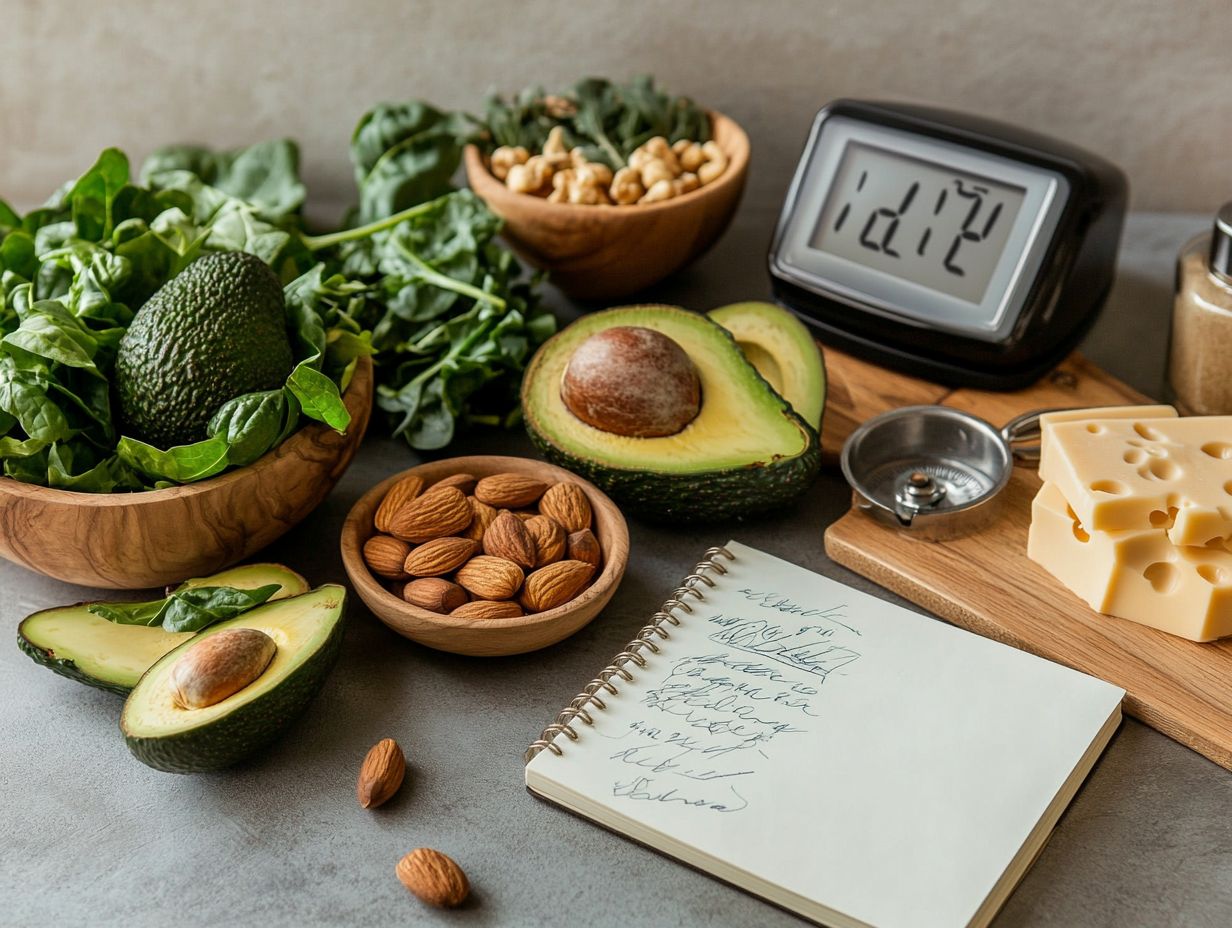
Adjusting your meal prep and the balance of fats, proteins, and carbohydrates in your diet is essential for matching your health goals and the ever-changing landscape of your metabolism. Regular adjustments can help in managing changes in how your body processes food and avoiding burnout from meal prep.
Recognizing when these adjustments are necessary is both a science and an art. It involves understanding the long-term effects of your dietary choices and how they impact your overall health conditions.
A weight stall signals that your body has adapted to your previous intake of fats and proteins, prompting the need to reassess your carbohydrate consumption. This reassessment may involve evaluating your caloric intake and fiber consumption to ensure they are matching your health goals.
Similarly, if you experience persistent energy dips throughout the day, it might indicate that your current keto diet is missing essential nutrients or that your meal timing could use some optimization. Research shows that short fasting periods can improve energy stability and appetite control.
Pay attention to your feelings of satiety and cravings, as they can offer valuable insights into whether your meals are balanced correctly. This can help in adjusting your macronutrient ratios and improving your overall protein intake, which is essential for muscle maintenance and growth.
By thoughtfully reflecting on these signs, you can make effective modifications to your meal prep, ensuring that you remain compliant with the ketogenic lifestyle while still achieving your desired health outcomes.
What are Some Sample Keto Meal Prep Recipes for a Balanced Diet?
Sample keto meal prep recipes offer you both inspiration and guidance as you navigate the journey of maintaining a healthy ketogenic diet, all while savoring delicious meals. Get ready to enjoy meals that support your health journey!
1. Chicken and Broccoli Alfredo: A Ketogenic Favorite
Chicken and Broccoli Alfredo is a rich and satisfying keto recipe that brings together tender chicken and nutritious broccoli in a creamy sauce, making it an excellent choice for meal prep.
This delightful dish not only caters to your low-carb lifestyle but also provides a hearty option for when you’re craving a comforting meal without the guilt. By focusing on wholesome ingredients, this recipe transforms the classic chicken and broccoli pairing into a luxurious Alfredo experience, featuring a velvety sauce crafted from cream and Parmesan cheese.
The use of seasoned chicken breast ensures maximum flavor, while the addition of fresh broccoli delivers essential vitamins and minerals. Perfect for those busy weekdays, this meal can be prepared in advance, stored in airtight containers, and easily reheated for a quick and delicious lunch or dinner option.
2. Salmon and Asparagus Salad
The Salmon and Asparagus Salad is a delightful and nutritious keto recipe that s brimming with healthy fats, perfect for your meal prep needs. This recipe follows dietary guidelines for heart health and weight management.
This refreshing dish beautifully combines the rich flavors of succulent salmon with vibrant, tender asparagus, resulting in a colorful meal that not only tantalizes your taste buds but also adheres to heart-healthy dietary guidelines.
Sourcing high-quality ingredients is key; consider stopping by local farmers’ markets for the freshest asparagus, and opt for wild-caught salmon, renowned for its omega-3 fatty acids that support your healthy fat intake and reduce metabolic risk factors.
Loaded with vitamins, minerals, and antioxidants, this salad promotes overall wellness and makes for a satisfying lunch or dinner option. It is an excellent choice for those looking to manage blood pressure and cholesterol levels through diet.
With straightforward preparation steps, you can whip up this invigorating salad in no time, ensuring that you enjoy both flavor and nutrition without the fuss.
3. Cauliflower Fried Rice: A Low-Carb Delight
Try this delicious Cauliflower Fried Rice today and enjoy all the flavor without the carbs! Cauliflower Fried Rice stands out as an exceptional low-carb alternative to traditional fried rice, perfectly suited for your keto meal prep needs. This dish cleverly replaces rice with finely chopped cauliflower, allowing you to indulge in a satisfying meal without the carb overload. It is a great option for those following a low-carbohydrate diet.
To prepare this culinary delight, start with fresh or frozen cauliflower florets, easily pulsed into rice-sized pieces. Saut them in a pan with a drizzle of olive oil, garlic, and onions to create a flavorful foundation that tantalizes your taste buds.
For added protein, consider enhancing your dish with options like:
- Scrambled eggs
- Diced chicken
- Shrimp
Feel free to elevate your creation by incorporating your favorite low-carb vegetables, such as bell peppers and zucchini. This not only boosts flavor but also enriches the nutritional profile, making it a versatile choice for anyone exploring low-carb options. This dish helps maintain proper vegetable intake and prevents nutrient deficiencies.
How to Store and Reheat Keto Meal Prep Meals for Maximum Freshness?
Storing and reheating your keto meal prep effectively is crucial for preserving both the flavor and nutritional value of your dishes, all while staying true to the principles of the ketogenic diet. Employing proper cooking techniques and batch cooking strategies can significantly aid in this process.
1. Proper Storage Techniques for Keto Meal Prep
Employing proper storage techniques is key to ensuring that your keto meal prep stays fresh, safe, and delicious for extended periods. Understanding these techniques is crucial for complying with dietary restrictions and avoiding meal prep burnout.
Utilizing methods like vacuum sealing can significantly extend the shelf life of your keto dishes by minimizing exposure to air, which helps prevent oxidation and nutrient degradation. This method keeps your meals healthy.
This technique is particularly beneficial for meats and vegetables, preserving their flavors and textures while also guarding against food spoilage.
Refrigeration plays a vital role in maintaining the quality of your various keto meals. When you store ingredients correctly in airtight containers, they can retain their nutritional value and freshness for several days.
Understanding these methods is essential for anyone looking to optimize their meal prep, ensuring that your low-carb dishes remain not only safe to eat but also a delight to savor.
2. Reheating Tips
Reheating your keto meal prep meals with care is essential for maintaining their quality, ensuring they remain both delicious and nutritious.
To achieve the best results, consider the most suitable reheating method based on the type of dish you’ve prepared. The microwave offers a quick option, but it s crucial to use a microwave-safe container and cover your meal to trap moisture, preventing any unwanted dryness.
For baked goods or casseroles, the oven is your best friend; preheating it to a moderate temperature, typically around 350 F, promotes even heating without the risk of overcooking.
Alternatively, if you re dealing with soups and sauces, the stovetop is an excellent choice. Just keep the flame low and stir frequently to help maintain the original texture and flavor of the dish.
By following these techniques, you can savor your meals while staying true to your dietary preferences.
What are Some Common Mistakes to Avoid in Keto Meal Prep?
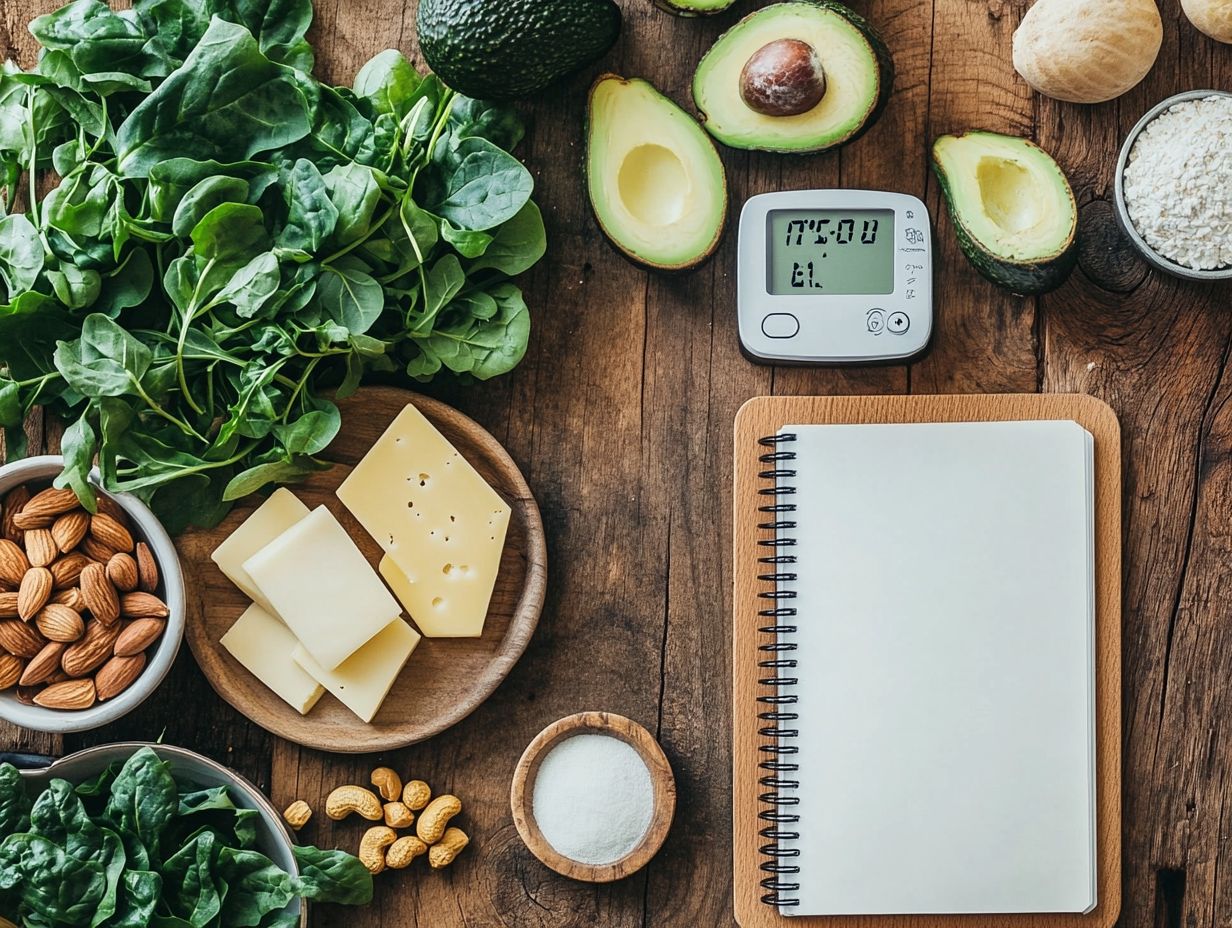
Avoiding common pitfalls can make your keto journey smoother and more enjoyable! Steering clear of common mistakes in keto meal prep is crucial for achieving a successful and sustainable ketogenic diet. This approach will help you navigate potential dietary challenges effortlessly, allowing you to fully embrace the benefits of this lifestyle without unnecessary hurdles.
1. Not Planning Ahead
One of the most critical missteps in keto meal prep is neglecting to plan ahead. This can easily lead to going off your diet and unhealthy food choices.
When you skip creating a structured meal plan, you invite impulsive eating and risk gravitating toward tempting high-carb alternatives that could throw you out of ketosis. This inconsistency can hinder your body s ability to burn fat, ultimately undermining the myriad health benefits of the ketogenic diet think improved mental clarity, enhanced energy levels, and even potential weight loss.
Committing to a ketogenic lifestyle demands dedication, and without a well-defined meal roadmap, you jeopardize your long-term health goals and the results you desire.
2. Not Tracking Macros Accurately
Failing to track your macros accurately is a common pitfall that can quickly derail your keto progress and compromise your dietary compliance.
When you overlook the importance of consistently monitoring your macronutrient intake, it can lead to imbalances that disrupt your carefully crafted ketogenic ratios. This oversight not only hinders your weight loss efforts but also diminishes the benefits of ketosis, increasing the risk of slipping back into carbohydrate reliance.
Inadequate tracking can result in unintended calorie surpluses or deficiencies, triggering cravings or energy dips, ultimately derailing your progress. It s vital to maintain diligence in tracking your macros for anyone dedicated to thriving on a ketogenic diet.
3. Not Varying Meals
Sticking to the same meals day in and day out is a common misstep that leads to boredom and pesky food cravings, making it tough to stay on track with a ketogenic diet.
Embracing meal variety makes your healthy eating journey exciting! By incorporating a diverse array of food groups, you can explore different flavors and textures, effectively preventing palate fatigue.
For example, experimenting with various protein sources such as fish, poultry, and even plant-based options alongside vibrant vegetables and healthy fats can transform dull meals into exciting culinary experiences. This approach enhances your satisfaction and supports nutritional balance, promoting your overall well-being.
Frequently Asked Questions
What are macronutrients and why are they important to balance in keto meal prep?
Macronutrients, or macros, refer to the three essential nutrients needed in large quantities by our body: carbohydrates, protein, and fat. Balancing these macros is important in keto meal prep as it ensures that you are consuming the right amounts of each to maintain ketosis and achieve your health goals.
What is the ideal macronutrient ratio for a keto meal prep?
The ideal macronutrient ratio for a keto meal prep is a diet high in healthy fats (70-75%), moderate protein (20-25%), and low in carbohydrates (5-10%). This ratio is essential for maintaining a state of ketosis and promoting weight loss.
How can I ensure I am balancing my macros in my keto meal prep?
To ensure you are balancing your macros in your keto meal prep, carefully plan and track your meals using a food journal or a nutrition app. This will help you keep track of your intake and adjust accordingly.
Can I still consume my favorite foods while balancing macronutrients in keto meal prep?
Yes, you can still enjoy your favorite foods while balancing macronutrients in keto meal prep. Just make healthier versions using low-carb substitutes and keep track of your portion sizes to stay within your macro goals.
What happens if I do not balance my macros in keto meal prep?
If you do not balance your macros in keto meal prep, you may not reach and maintain a state of ketosis. This can hinder your health goals and lead to potential side effects such as fatigue, cravings, and weight gain.
With the right strategies, you can enjoy a fulfilling keto lifestyle!
Are there any tools or resources available to help with balancing macros in keto meal prep?
Yes, there are many tools and resources available to help with balancing macros in keto meal prep.
These resources include nutrition apps, online calculators for macronutrients (the nutrients that provide calories: carbohydrates, proteins, and fats), and meal planning guides designed for the keto diet.
Ready to take your keto meal prep to the next level? Discover the best tools and resources to balance your macronutrients!

